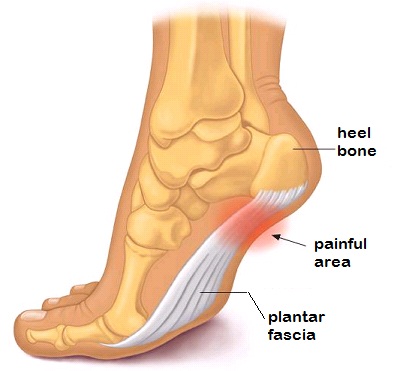Plantar Fasciitis and Heel Pain
Heel pain is a very common problem with many possible causes. Though it can be due to a systemic disease such as arthritis which can affect any joint in the body, there are a lot more conditions that can affect the foot locally. For this reason, it is essential to get the correct diagnosis based on the signs and symptoms, physical examination, and history because each cause is treated differently.
The most common cause of heel pain is plantar fasciitis. The plantar fascia is a strong connective tissue that attaches to the calcaneus bone or the heel bone to the toes of the foot. It maintains the arch of the foot. The plantar facia is constantly under stress during walking or running. Generally, this structure commonly gets injured due to overstretching or carrying or pushing heavy loads. This may cause very small tears on the fascia near the heel bone resulting in inflammation and pain.
Plantar fasciitis often affects individuals who are overweight, pregnant women, patients with diabetes, and those who wear improper footwear. Athletes like runners, volleyball players, tennis players, and soccer players are also often affected. Advancing age is also a common cause of plantar fasciitis because of the natural degenerative changes that occur.
Signs and symptoms:
1. Severe pain at the bottom of the heel.
2. Pain after prolonged standing or walking.
3. Pain while resting which can continue throught the day.
4. Inability to walk straight.
Diagnosis:
Getting a thorough medical history, physical examination, taking note of pertinent signs and symptoms are important in arriving at an accurate diagnosis. Also, diagnostic imaging techniques such as x-ray, ultrasound and other imaging modalities, laboratory work like blood uric acid levels may be done to rule out arthritis.
Treatment of plantar fasciitis:
1. Rest the affected foot
2. Limit activities
3. Stretching before walking or any activity
4. Ice packs
5. Buy special footwear for heel pain (Naples z-coil)
Surgery:
Although most patients recover from non-surgical treatments, there is a very small percentage where surgery is required.
ESWT:
This means Extracorporeal Shock Wave Therapy, which is a painless way of treating chronic heel pain such as plantar fasciitis heel pain. Read more on ESWT.
Plantar fasciitis often affects individuals who are overweight, pregnant women, patients with diabetes, and those who wear improper footwear. Athletes like runners, volleyball players, tennis players, and soccer players are also often affected. Advancing age is also a common cause of plantar fasciitis because of the natural degenerative changes that occur.
Signs and symptoms:
1. Severe pain at the bottom of the heel.
2. Pain after prolonged standing or walking.
3. Pain while resting which can continue throught the day.
4. Inability to walk straight.
Diagnosis:
Getting a thorough medical history, physical examination, taking note of pertinent signs and symptoms are important in arriving at an accurate diagnosis. Also, diagnostic imaging techniques such as x-ray, ultrasound and other imaging modalities, laboratory work like blood uric acid levels may be done to rule out arthritis.
Treatment of plantar fasciitis:
1. Rest the affected foot
2. Limit activities
3. Stretching before walking or any activity
4. Ice packs
5. Buy special footwear for heel pain (Naples z-coil)
Surgery:
Although most patients recover from non-surgical treatments, there is a very small percentage where surgery is required.
ESWT:
This means Extracorporeal Shock Wave Therapy, which is a painless way of treating chronic heel pain such as plantar fasciitis heel pain. Read more on ESWT.
Call us now:
(239) 430-3668 (FOOT)
Self service # (239) 420-7170
